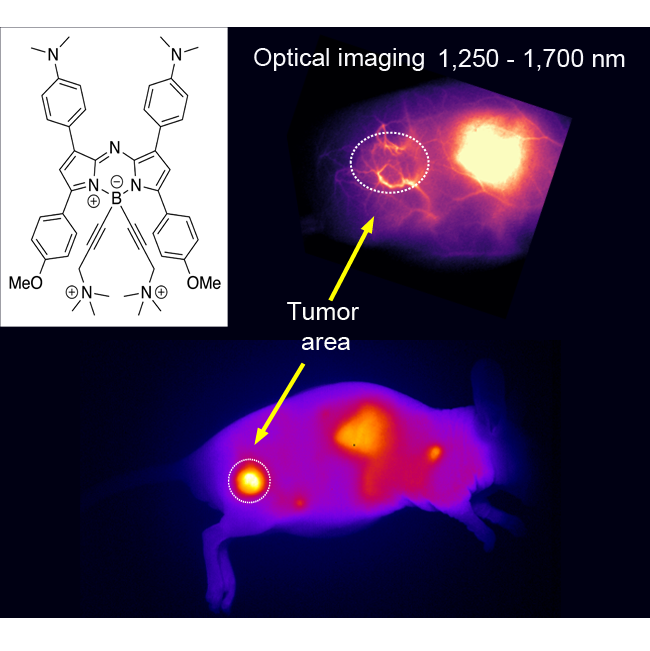Aza-BODIPY derivatives as NIR-II fluorophores for research and clinical imaging
Small molecular and biocompatible NIR-II organic fluorescent dyes for in vivo imaging
- Accueil /
- Nos offres innovantes /
- Thérapeutique
Avantages concurrentiels
New aza-BODIPY fluorophores disclosed are water-soluble, and specifically emit in the optical window ranging from 1000 to 1700 nm, whether they are alone, encapsulated or coupled to any molecule of interest (as an antibody or a biological ligand) or cell of interest (as a macrophage or a stem cell). Furthermore, preliminary assays on mice reported no toxicity of the compounds (Godard 2020).
Opportunités de marché
- Important growth of global NIR imaging market within the next 6 years led by cancer diagnosis, cancer, plastic, gastrointestinal and cardiovascular guided surgeries applications (from several hundred M$ in 2019 to 1.2 B$ by 2026)
- Driven by increasing demand for Contract Research Organizations (CROs) to conduct NIR clinical trials, prevalence of chronic diseases
- Hospital and clinics represent the fastest growing end-user segment as optical imaging methods and devices will fastly be adopted in the operating room
- Considerable growth of NIR imaging reagents segment led by ICG the only approved fluorescent dye for clinical use with current devices (e.g. SPY elite, PINPOINT, and SPY-PHI)
- Other reagents, more adapted to in vivo use in the NIR II/SWIR range spectrum may represent serious challengers on cancer applications.
Stade de développement
This technology is being matured at SATT Linksium in order to:
- Optimize the synthesis (upscaling, bioconjugation, bimodality)
- Optimize the conditions of use and realize a proof of concept (POC) for bimodality and image guided surgery
TRL3/4
Partenariat recherché
Technology available for licensing ; collaborative research project also considered
The project is currently under maturation process at SATT Linksium
Propriété intellectuelle
Results and application are patent pending (EP19315089; priority date: 08/08/2019)
Chercheur / Laboratoire
Lucie Sancey / IAB
Présentation
Medical imaging plays a critical role in cancer diagnosis but also in the improvement of the speed and accuracy of tumor resection during surgery. As traditional imaging modalities suffer from several constraints such as disruption of the surgical workflow, optical imaging methods have received tremendous interests for use in real-time image-guided surgery. Among them, second near-infrared wavelength window (NIR-II or SWIR, 1000-1700 nm) fluorescent imaging can probe tissue at centimetre depths and achieve micrometre-scale resolution at depths of millimetre. Unfortunately, few clinically suited NIR-II dyes are available so far that would permit the translation of NIR II fluorescence guided surgery to clinical practice.
Researchers at the Institute for Advances Biosciences (Grenoble Alpes University, CNRS, France) and ICMUB (University of Burgundy, Dijon, France) have developed innovative organic contrast agents capable of emitting in the NIR-II detection wavelength range. These fluorescent molecules are aza-BODIPY derivatives, which display both optical and biocompatible features (including correct persistence and excretion criteria as well as potentially no adverse effects) enabling their use for in vivo imaging and guided surgery.

Applications
Several NIR fluorescence imaging systems are now available for pre-clinical and clinical studies which provide the surgeon with a guiding signal otherwise invisible. Systems and dyes (eg indocyanine green, ICG) are even approved by health governmental agencies (eg FDA, EMA) for use in humans. NIR II spectral range imaging has a deeper penetration depth, higher resolution and weak auto-fluorescence over NIR I; which is highly suitable for biomedical imaging. If optical systems and sensor for NIR-II imaging are becoming more performant and may enter soon the operating room there is a lack of dyes with peak emission in the NIR II/SWIR that would display all the suitable criteria for clinical use in humans. Indeed, ICG is fastly excreted which is limiting its clinical use.
New aza-BODIPY fluorophores can be used as contrast agent for fundamental scientific research and clinical applications:
- For fluorescence-guided surgery or multimodal imaging-guided surgery (in combination with photoacoustic, nuclear imaging or MRI as example),
- As fluorescent vector of small entities as 10B-BSH for boron-neutron capture therapy (Xuan 2016; Miyatake 2018; Aihara 2014), for imaging and therapeutic applications,
- As fluorescent labeling of a biological target (such as a healthy or tumor cell, a protein, DNA, RNA, a lipid, or any other animal or plant biological target part) for in vitro applications as already implemented with NIR-I imaging contrast agents
Bibliography
- Barabino et al. Surg. Innov. 2016, 23: 354-359
- Bettega et al. Fluorescence Imaging for Surgeons, Springer, 2015.
- Xuan et al. J Med Chem. 2016; 59(5): 2109-17.
- Miyatake et al. Prog Neurol Surg. 2018; 32: 48-56.
- Aihara et al. Appl Radiat Isot. 2014; 88: 12-5.
- Godard et al. Bioconjugate Chem 2020 doi: 10.1021/ acs.bioconjchem.0c00175.
Contacts

7 Allée Palestine
38610 Gières
Tél : +33 (0)4 56 52 04 30
E-mail : contact@floralis.fr




